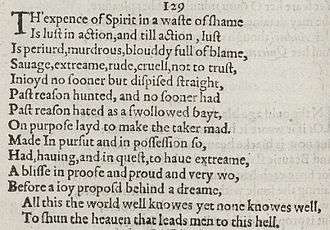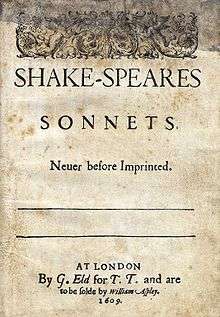Sonnet 129
| Sonnet 129 | |||||||
|---|---|---|---|---|---|---|---|
 Sonnet 129 in the 1609 Quarto | |||||||
|
| |||||||
| |||||||
Sonnet 129 is one of the 154 sonnets written by William Shakespeare. The 154 sonnets are typically divided between the "Fair Youth" sonnets (1–126) and the "Dark Lady" sonnets (127–152). There is no evidence that this division follows the chronology of the sonnets. The composition date is unknown but it was published along with the rest of the sonnets in the 1609 Quarto.
Overview
Sonnet 129 is one of Shakespeare's most famous sonnets and centers around the idea of the human mind and its primal urges. The sonnet consists of an unknown narrator having an internal mediation with himself about his sexuality; he fears it and harvests feelings of self-disgust for having such desires. "Omne animal post coitum triste est" is a Latin saying that is often quoted in association to sonnet 129. The phrase literally translates into "after sex, every animal is sad", because that is the message that the sonnet conveys. It speaks of the temptations of sex and the disappointments that it leads to. Shakespeare builds up the sonnet with imagery and desire. Shakespeare then ends it with the feeling of being a victim to lust, as well as the feelings of defeat and disappointment that ensue after the act is done and the desire is no longer there. "Sonnet 129 fixes and deprecates lust with...murderous precision"[2] and Shakespeare leaves us questioning our own primal urges.
Structure
Sonnet 129 is an English or Shakespearean sonnet. The English sonnet has three quatrains, followed by a final rhyming couplet. It follows the typical rhyme scheme of the form abab cdcd efef gg and is composed in iambic pentameter, a type of poetic metre based on five pairs of metrically weak/strong syllabic positions. The 8th line exemplifies a regular iambic pentameter:
× / × / × / × / × / On purpose laid to make the taker mad: (129.8)
- / = ictus, a metrically strong syllabic position. × = nonictus.
Line 4 begins with a common metrical variant, the initial reversal:
/ × × / × /× / × / Savage, extreme, rude, cruel, not to trust; (129.4)
The stressed nonictus "rude" increases the heaviness of the list. An initial reversal is also found in line 9; mid-line reversals potentially occur in lines 9 and 14.
The meter demands a few variant pronunciations: line 3's "murderous" functions as two syllables, line 5's "despised" as three, and line 14's "heaven" as one.[3]
Context
Sonnet 129 is set between two relatively light and heavy sonnets. Scholars tend to play down its inherent darkness. Despite its intensity and harsh tone, it may have been written from a detached viewpoint. Shakespeare is capable of portraying issues and evoking emotions without having any personal involvement or experience in them. Such examples are shown when he depicts the lust of Tarquin in The Rape of Lucrece; he also looked into the scheming of Angelo in Measure for Measure, a man whose sexual appetite causes a rippling effect on his life; he was also able to portray the jealousy, racism, and passion in Othello. Shakespeare uses a similar theme again with Leontes in his play, The Winter's Tale.[4]
The placement of the sonnet leads many to believe that Shakespeare had a direct relation with the "dark lady" (as referenced as the inspiration for sonnets 127-152). Many scholars believe that Shakespeare had an affair and that a mistress was his inspiration for writing as many poems as he did. Even though such a relation was frowned on at the time, it has not been ruled out as a possibility. However, because there are no historical records that such a woman existed, there is not a sufficient evidence to determine whether the woman spoken of in the sonnets was real or fictitious. The sexual pessimism depicted in the sonnets, although extreme, is not unusual to the Christian tradition, especially in ancient times. Beliefs and standards of virginity and sexual abstention can be dated back to Pythagoras, and the views continued to be a tradition through Plato and the Stoics. Sexual pessimism existed before Christianity became a widespread religion.[5]
Exegesis
Overview
Scholars generally agree that "in sonnet 129, Shakespeare describes graphically both the physical and psychological devastation of 'lust'".[6] Lust is a powerful emotional and physical desire that feels overwhelmingly like heaven in the beginning but can, and often does, end up being more like its own torturous hell in the end. During the time in which Shakespeare wrote Sonnet 129, virginity was protected and women who were promiscuous or adulterers were shunned and this behavior was not an acceptable societal behavior. Lust drives the desire to be with another person, sometimes casting your social norms and ethical behavior aside to fulfill that desire. When you give in to desire, or lust, and the act is complete, then the emotion of lust is filled with fear, anger, disgust and hate until the desire to feel lust again overtakes you. It's important to note that sexually transmitted diseases were not only common during this time period, but were often left untreated or incurable. Giving in to lust and desire was dangerous from not only a societal view but from a medical standpoint as well. Shakespeare's Sonnet 129 graphically displays the struggle between heaven and hell, lust and promiscuity and its aftermath. "The aura surrounding physical sex in this sonnet, an inextricable mingling of attraction and revulsion."[7]
Quatrain 1
The first quatrain in 129 generally has two scholarly views, the first of which seems more apparent where Shakespeare is writing about his self-hate. "Th'expense of spirit in a waste of shame' ... reads like a poem of self-condemnation for the poet's subjugation to sexual desire".[8] Shakespeare was aware of the consequences of giving into desire and the "murderous, bloody, full of blame" dark feelings that would inevitably follow.
The second view is that "in action, lust is the expenditure of vital power (mind and semen)".[8] The "expense of spirit" or expending semen and "waste of shame" "carried the meaning of chastity and genitalia, as parts of shame"[8] were important in Shakespeare's era. Giving into lust so lightly and without regard to the power that you are giving up, could end in "extreme, rude, cruel" consequences that could not be undone.
While sonnet 129 does not directly reference the "Dark Lady", scholars generally agree that the "Dark Lady" is seen in this sonnet subtly. Shakespeare uses dark, ugly words such as "murderous, bloody, savage" which scholars believe was directly attributed to the sexual act and lust Shakespeare had toward the "Dark Lady".
Quatrain 2
Shakespeare's second quatrain tells the reader that "as soon as lust is experienced, it is immediately hated".[5] "Beyond the control of reason"[5] the aggressor is searching for and looking forward to the pleasure that awaits. Shakespeare's "context is equivalent 'to have intercourse', 'to possess sexually'".[5] The hate that is experienced after lust, is almost "irrational as was the original pursuit and like a bait that a fish swallows".[5] The bait is an example of lust; it is not to drive the aggressor crazy, but rather to attract a mate. The lust, in the process can drive the aggressor mad and lose all control.
Quatrain 3
Shakespeare's third quatrain is interesting in that it changes "the words used to characterize the negative aspects of lust".[9] Lust becomes "perceptibly weaker toward the end of the poem"[9] then in the start. In the beginning of the sonnet, Shakespeare uses the words "Murd'rous", "bloody", "savage" and "cruel" and replaces them in this quatrain with "a very woe" and "a dream".[6] Shakespeare is thought to have confirmed his feelings in the beginning of the poem that lust is not to be given into and by the last quatrain and even into the below couplet, it is as though he has given in to the inevitable and knows that it is all but impossible to overcome lust.
Couplet
The couplet that closes sonnet 129 is arguably a change in tone compared with the rest of the sonnet. "The concluding couplet is one expressing a wryly regretful acceptance of the inevitable, rather than constituting a climax to the angry denunciation of the opening lines."[6] Scholars generally agree that the sonnet is dictated from a male perspective. At times, Shakespeare would appear to have cynical and bitter views about sexuality. On the contrary, it is also easy to find just as many passages in Shakespeare's work that have a positive outlook on sexual relations between men and women. The opposite of this is evidenced in Sonnets 56, 116, and 147, among many others.
Interpretations
- Ralph Fiennes, for the 2002 compilation album, When Love Speaks (EMI Classics)
References
- ↑ Pooler, C[harles] Knox, ed. (1918). The Works of Shakespeare: Sonnets. The Arden Shakespeare [1st series]. London: Methuen & Company. OCLC 4770201.
- ↑ "Detachment and Engagement in Shakespeare's Sonnets: 94, 116, and 129". www.jstor.org.ezp2.lib.umn.edu. Retrieved 2015-10-08.
- ↑ Kerrigan 1995, pp. 141, 358.
- ↑ Edmondson, Paul; Wells, Stanley (2004-09-30). Shakespeare's Sonnets. OUP Oxford. ISBN 9780191555091.
- 1 2 3 4 5 "Shakespeare's Sonnets". www.shakespeares-sonnets.com. Retrieved 2015-10-08.
- 1 2 3 ""Behind a dream": Cleopatra and Sonnet 129". Retrieved 2015-10-21.
- ↑ ""Vilia Miretur Vulgus": Shakespeare and the snipers.". go.galegroup.com.ezp1.lib.umn.edu. Retrieved 2015-10-21.
- 1 2 3 Jakobson, Roman; Jones, Lawrence G. (1970-01-01). Shakespeare's Verbal Art in "Th' Expense of Spirit". Walter de Gruyter. ISBN 9789027905123.
- 1 2 "Shakespeare's SONNET 129". web.a.ebscohost.com.ezp3.lib.umn.edu. Retrieved 2015-10-21.
Further reading
- First edition and facsimile
- Shakespeare, William (1609). Shake-speares Sonnets: Never Before Imprinted. London: Thomas Thorpe.
- Lee, Sidney, ed. (1905). Shakespeares Sonnets: Being a reproduction in facsimile of the first edition. Oxford: Clarendon Press. OCLC 458829162.
- Variorum editions
- Alden, Raymond Macdonald, ed. (1916). The Sonnets of Shakespeare. Boston: Houghton Mifflin Company. OCLC 234756.
- Rollins, Hyder Edward, ed. (1944). A New Variorum Edition of Shakespeare: The Sonnets [2 Volumes]. Philadelphia: J. B. Lippincott & Co. OCLC 6028485.
- Modern critical editions
- Atkins, Carl D., ed. (2007). Shakespeare's Sonnets: With Three Hundred Years of Commentary. Madison: Fairleigh Dickinson University Press. ISBN 978-0-8386-4163-7. OCLC 86090499.
- Booth, Stephen, ed. (2000) [1st ed. 1977]. Shakespeare's Sonnets (Rev. ed.). New Haven: Yale Nota Bene. ISBN 0-300-01959-9. OCLC 2968040.
- Burrow, Colin, ed. (2002). The Complete Sonnets and Poems. The Oxford Shakespeare. Oxford: Oxford University Press. ISBN 978-0192819338. OCLC 48532938.
- Duncan-Jones, Katherine, ed. (2010) [1st ed. 1997]. Shakespeare's Sonnets. The Arden Shakespeare, Third Series (Rev. ed.). London: Bloomsbury. ISBN 978-1-4080-1797-5. OCLC 755065951.
- Evans, G. Blakemore, ed. (1996). The Sonnets. The New Cambridge Shakespeare. Cambridge: Cambridge University Press. ISBN 978-0521294034. OCLC 32272082.
- Kerrigan, John, ed. (1995) [1st ed. 1986]. The Sonnets ; and, A Lover's Complaint. New Penguin Shakespeare (Rev. ed.). Penguin Books. ISBN 0-14-070732-8. OCLC 15018446.
- Mowat, Barbara A.; Werstine, Paul, eds. (2006). Shakespeare's Sonnets & Poems. Folger Shakespeare Library. New York: Washington Square Press. ISBN 978-0743273282. OCLC 64594469.
- Orgel, Stephen, ed. (2001). The Sonnets. The Pelican Shakespeare (Rev. ed.). New York: Penguin Books. ISBN 978-0140714531. OCLC 46683809.
- Vendler, Helen, ed. (1997). The Art of Shakespeare's Sonnets. Cambridge, MA: The Belknap Press of Harvard University Press. ISBN 0-674-63712-7. OCLC 36806589.
.png)
